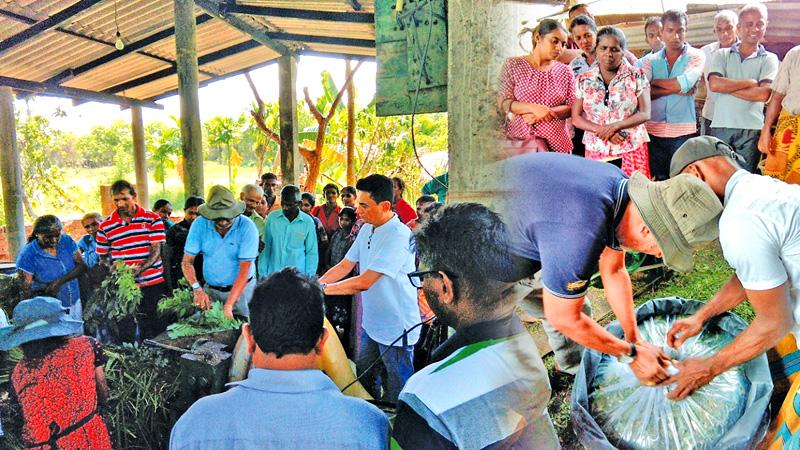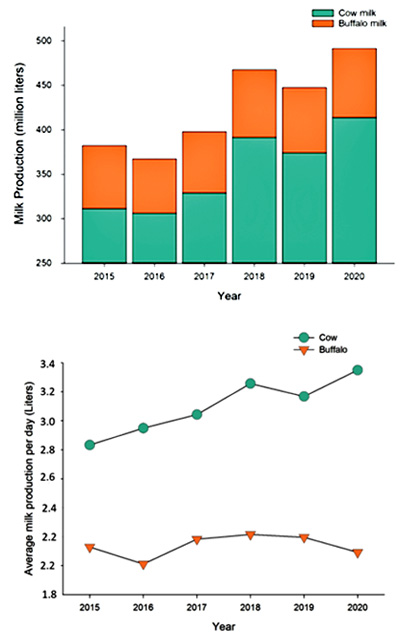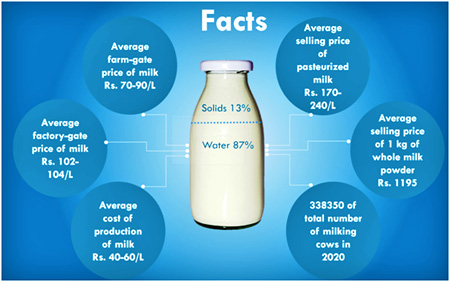
For many, dairy products have been an integral part of day-to-day lifestyle, e.g., enjoying a cup of milk tea in the morning, yoghurt or cheese as a snack and ice cream as a dessert are some of the common encounters of processed dairy products for an average Sri Lankan.
 Hence, milk and dairy products are becoming an indispensable commodity in Sri Lankans’ lifestyles. Clear proof for this claim is the recently escalated tension among the island-wide dairy consumers with the abrupt market shortages in the supply of retail milk powder packages.
Hence, milk and dairy products are becoming an indispensable commodity in Sri Lankans’ lifestyles. Clear proof for this claim is the recently escalated tension among the island-wide dairy consumers with the abrupt market shortages in the supply of retail milk powder packages.
Except for dairy production, most of the other animal-derived food production sectors (egg, chicken meat, and fresh fish) are either self-sufficient or barely sufficient in Sri Lanka.
Thus, the growing demand for fresh milk and dairy products has created a vacuum in this volatile business, while increasing the country’s dependency on imports. Nevertheless, the Sri Lankan dairy industry is a 55-60 billion rupees (US$ 300 million per annum) business that the country spent only on the import of milk and milk products to fulfill the gap in dairy production.
Building resilience in this most volatile and sensitive dairy industry in Sri Lanka has to be achieved with careful planning and integrated quality management throughout the dairy supply chain.
In this article, we closely examine the current status of the SriLankan dairy sector and its potentials in increasing production to meet the ever-growing demand in the path to self-sustaining the country’s need for dairy. We present numerous suggestions based on our expert analysis of the current situation and recent trends.
Current status
The dairy farming sector in Sri Lanka is dominated by smallholder subsistence farmers and nearly 85-90 percent of local milk production originates from small holder farmers in the country.
Approximately, 72,400 families depend on dairy as their main source of income. Medium and large-scale dairy farms are primarily state-owned while some privately-owned medium-scale farms have begun their operations during the last few years.
The Government’s national policy framework ‘Vistas of Prosperity and Splendour’ was established to assist short- and long-term plans in collaboration with the public and private sectors to meet the local demand for liquid milk.
Moreover, the import policies implemented due to Covid-19 has allowed local farmers to establish themselves in the industry. Further, consumer trust in locally manufactured processed dairy products such as powdered milk has increased dramatically in the recent past.
In 2020, Sri Lanka produced 491.5 million litres of milk (cow and buffalo milk collectively), according to the recent report produced in 2021 from the Department of Census and Statistics in Sri Lanka.
Out of this, 413million litres were accounted by dairy cows, whereas the rest (78million litres) was produced by water buffalos (Figure 1). At present, only 40-41 percent of milk requirement is produced within the country, indicating the larger gap of being self-sufficient in milk. To be self-sufficient from milk, Sri Lanka needs to produce 1200 million litres of milk per year, where the current production volume is around 491 million litres only.

Average milk production from a dairy cow was 3.35 litres per day in 2020, where it has been increased from 2.83litres per day in 2015 (18.3 percent increment). This was probably due to the certain dairy development activities that have taken place, especially the introduction of exotic breeds directly to the genetic pool in Sri Lanka between 2012-2017.
Based on recent statistics, the average milk production of cows or buffalo needs to be increased to 9.72 (from 3.35) litres per cow alone in a day or 7.47 litres per cow and buffalo in a day to meet the national fresh milk requirement of Sri Lanka. In reviewing this long term goal of nearly increasing the current production level thrice, we attempted to explain potential strategies and feasibility of meeting this goal.
How can the dairy industry prepare for the future?
The low productivity of dairy herds has been the major limiting factor to achieving increased milk production. If we closely examine the underline reasons for this low productivity, four key reasons can be identified.
Dairy cow feeding and nutritional issues
Around 75 percent of the variation in milk production between dairy animals is determined by environmental factors, out of which nutrition or feeds make up the largest portion. Ensuring the availability of adequate quantity and quality of feed for the animals is essential to achieve their potential genetic performance.
To produce milk in the mammary gland of a cow, good nutrition and feeding practices are essential. For this, dairy cattle should consume a sufficient quantity of good quality forage materials, water and maybe concentrates to provide other required nutrients.
Successful rationing of balanced feed is therefore of utmost importance for dairy cows. Yet, many dairy farmers are not giving uniform quality feeds with consistent nutritive value year-round and abrupt change of diet could also cause many ill effects on cow performance.
The majority of Sri Lankan dairy farmers are smallholders, depending on communal lands or naturally available grasslands for feeding the animals.
The quality, as well as quantity of such forages, varies frequently. Most of the large scale and medium scale dairy farms are not in a capacity to produce the required quantity of quality forages within their farms.
 This obstacle could be overcome by outsourcing the required forages for quality and steady supply at a reasonable cost. Therefore, non-dairy entrepreneurs involved in quality forage production will have to play a vital role in the future dairy development in the country by bridging the prevailing gaps in feed quantity and supply.
This obstacle could be overcome by outsourcing the required forages for quality and steady supply at a reasonable cost. Therefore, non-dairy entrepreneurs involved in quality forage production will have to play a vital role in the future dairy development in the country by bridging the prevailing gaps in feed quantity and supply.
Not to forget, providing an adequate amount of clean and fresh water to drink throughout the day is crucial, as cow milk consists of 87-88 percent of water. However, this is often neglected by dairy farmers in Sri Lanka, where cows do not get clean, fresh and adequate amounts of water throughout the day to maintain the milk production and feed intake.
Water scarcity during the long dry season from May to October every year negatively affects pasture cultivation and water for the consumption of animals especially in dry zone areas in Sri Lanka. This is one key challenge faced by extensive dairy farmers, where water supply heavily depends on rainfall.
In such contexts, roughage availability is seriously critical during the dry season or cows get to consume poor quality roughages that are normally lacking the usual nutritional quality that could have been adequately available in forages. However, being a tropical country with no seasonality, year-round forage production or collection of roughages is somewhat possible.
Proper rainwater management strategies should be adopted such as conservation (soil moisture), collection (groundwater storage, surface, tank, dam and reservoir) and relocation (surface drainage and subsurface drainage) for forage production. In addition to that when abundant forages are not available, farmers should adopt strategies to preserve the forages during times of high availability.
Low productivity of dairy herds and imported breeds
At present, dairy herds are not producing the potential milk yield, mainly due to interconnected reasons as explained within this article. Attempts should be made to improve the productivity of dairy herds within differing farming systems using specific strategies. Many small scale dairy farmers are rearing indigenous animals with low production potential under extensive/semi-intensive systems using family labour.
Cattle and buffalo breeding programs must be designed in reviewing the favourable cow and buffalo traits (e.g., milk yield, fertility, temperament, feed intake and disease resistance and so on) identified by farmers in different agro-ecological zones.
Nucleus herds should be maintained by the National Livestock Development Board (NLDB) and provide replacement herds or good quality semen as per the requirements of regional dairy farmers.
Efforts made for genetic upgrading of indigenous cattle and buffalo have been hampered due to inconsistencies in breeding policy implementation; scarcity of suitable proven breeding stocks for natural breeding, discontinuation or disruption of the initiated breeding programs; inadequacy of skilled artificial insemination (AI) technicians at field level; incorrect timing of insemination, poor infrastructure, lack of proper record-keeping system among farmers on breeding, inadequate follow-up on AI; poor attitude of the farmers on AI, poor extension service and insufficient participation of the private sector.
The Government imported improved crossbreeds from 2012/2014 to 2017 and offered at a low interest rate to new dairy farmers, as a step to boost the island’s dairy sector. However, it has not been key leverage to the industry, since new dairy farmers were lacking the essential experiences, knowledge and skills to handle the high yielding dairy cows.
Hence, such an approach in the future must focus on providing cows with high milking potentials for either nucleus farms or large scale, intensive farms, where dairyman has more experience in managing such breeds by providing ideal conditions. Gradually these breeds should be introduced to production farms with proper extensions and training.
Issues related to raw milk quality and husbandry practices
Raw milk quality regulations and standards must be adopted in milk procurement since optimal raw material quality is essential in producing high quality and safe dairy products.
This is critical since milk is perishable and often subjected to microbial quality deterioration, if not chilled immediately after milking.
This is most common among the small-scale dairy farmers since on-farm chilling is practically limited and thus, milk is kept at ambient temperature until it reached the regional chilling centres or pickup by the middleman or milk collector.
Therefore, time taken from milking to chilling may vary due to various practical reasons leading to issues related to microbial quality and safety of raw milk.
Many farmers do not get evening milk mainly because they do not have proper chilling facilities nearby. Another key issue in the dairy value chain is intentional adulteration with foreign materials (e.g., water, starch, salt, sugar and so on,) before submitting them to milk chilling or collecting centres.
Some of the other common issues related to raw milk quality are, presence of antibiotic residues that have been used to treat cows with infections, higher somatic cell contents in milk, presence of fungal toxins (e.g. Aflatoxin M1) and inferior raw milk composition (e.g. low fat and solid non fat contents).
These issues can be mitigated, only by adopting proper and appropriate quality control programs that can be introduced to the dairy supply chain, as key prerequisites (good agricultural practices, good hygenic practices, good veterinary practices and good manufacturing practices).
To improve milk quality, uplifting dairy husbandry practices are also essential. For this, raising healthy cows and heifers, maintaining healthy and productive cows as well as proper nutrition interventions are important for the sustainable intensification of milk production. Dairy farmers should maintain proper record-keeping practices on the growth, health and breeding of their dairy cows. Calves should be fed colostrum, vaccinated and take measures to reduce stress to prevent diseases. It is, therefore, important to early diagnose and treat diseases, without letting those be critical and impose serious health risks.
Proper planning and construction of a farming environment for optimal cow comfort and welfare are other key parameters to reduce the stress of cows to ensure better productivity.
Detecting estrus, successful natural or artificial insemination and timely diagnosis of pregnancy are three important parameters to keep the dairy herd profitable. Farmers should carefully plan and adopt a sound culling and recruitment program for their dairy herds to maintain the optimal productivity of the herd.
Policies and strategies for dairy development
Small-scale dairy farming in Sri Lanka mainly is for self-sustenance and selling off excess. Value addition is a key to success in any industry, where dairy farming is not an exception. Farmers, at their level best, if adopting to add value to raw milk, can earn a higher profit margin than that of selling unprocessed milk.
As an example, the cost of production of one litre of cow milk ranges from Rs. 40-60 and a regular farmer can get around Rs. 70-90 per litre by selling unprocessed milk, whereas processed milk, e.g. pasteurised milk can easily get a market price of 220-240 per litre.
For this, entrepreneurs mindsets, skills should cultivate within existing dairy farmers or encourage newcomers who would like to invest their time and effort in setting up new business ventures for value addition to raw milk.
Another policy-related concern is disposing of bull calves, since it’s increasingly becoming a societal problem, due to religious issues. However, for the profitable and well-functioning dairy industry, the culling of male calves and less productive lactating cows are key husbandry practices.
Alternative for this practice is to use quality sexed semen that would eliminate the possibilities of delivering male calves. However, technical feasibility, availability and cost are needed to account for such an expensive approach.
Another policy related environmental issue is disposing of manures. For this, at present, dairy farmers can invest in compost production, in line with recent Government policies for promoting organic agriculture.
Inconsistence policies have been a key issue for dairy farmers, as dairy policies and breeding policies are not going hand in hand. Always, policies should be aimed at promoting the dairy industry by facilitating easy workflow for dairy farmers through reducing bureaucratic procedures that often need to deal with cross functioning institutions or departments.
Providing services to stakeholders in the dairy industry should be centralised and act in harmony with a service-oriented focus. Conflicts between dairy farmers and Government officials/policies, e.g., the use of natural pasturelands for grazing should be critically evaluated to find feasible solutions. Another policy-related issue is not identifying forage as an important crop within agricultural practices.
Because of this, dairy farmers can not invest in maintaining a large scale forage production land, since water for irrigating or fertiliser subsidies are not provided for such cultivations, although it is a key part of dairy farming.
The recent Covid-19 pandemic has also affected the dairy sector. If we do not safeguard our existing dairy industry, then employers might start “laying off” their employees because owners will not be able to run their businesses profitably.
This would also create a high un-employability rate within the country. That will cause certain other social unrests as well. Policy directions should be in line with safeguarding the existing dairy industry while facilitating their activities such as providing tax exemptions for imported feed ingredients such as maise, soybean meal, vitamin and mineral supplements that have been heavily used for manufacturing of concentrate feeds and also machinery that has been used in farms and processing industries.
Outlook of dairy Industry
In reviewing the current status, achieving self-sufficiency is a journey that needs to be undertaken together with the participatory approach of all key stakeholders.
Expanding the dairy industry is feasible within the country, where required capacities and potential are available within dairy farmers if those skills are properly identified and trained. Dairy farmers should primarily focus on providing adequate nutrition to cows, including clean and fresh water throughout the day.
Additionally, it’s important to adopt good agricultural and management practices to ensure the wellbeing of the cow and productivity at the farm to produce high-quality raw milk. Harnessing the potentials of dairy herds can be gained through proper breeding and genetic intervention of the dairy herds in the country.
Farmers should pay special attention to increasing or maintaining the quality and safety of raw milk through immediate chilling of milk. This can be achieved through strengthening the milk collection network, establishing small scale communal milk chilling hubs for both morning and evening milking.
Thereby, the dairy process will be able to produce high-quality dairy products with enhanced safety and with less waste.
Policy interventions to facilitate and enhance local dairy is a way forward in achieving increased milk production. For this, societal change from a dairy farmer to an entrepreneur should be promoted. Providing hands-on experiences and updated know-how is essential in the capacity building of dairy farmers and entrepreneurs.
Dr. Hasitha Priyashantha is affiliated to the Swedish University of Agricultural Sciences, Uppsala, Sweden and his research focus is how raw milk and product quality characteristics are affected by dairy farming. He can be contacted via [email protected]
Prof. Janak. K. Vidanarachchi is a professor in Animal Science at the University of Peradeniya, and he conducts research and training on wider aspects covering the dairy industry in the country. He can be contacted via [email protected])
